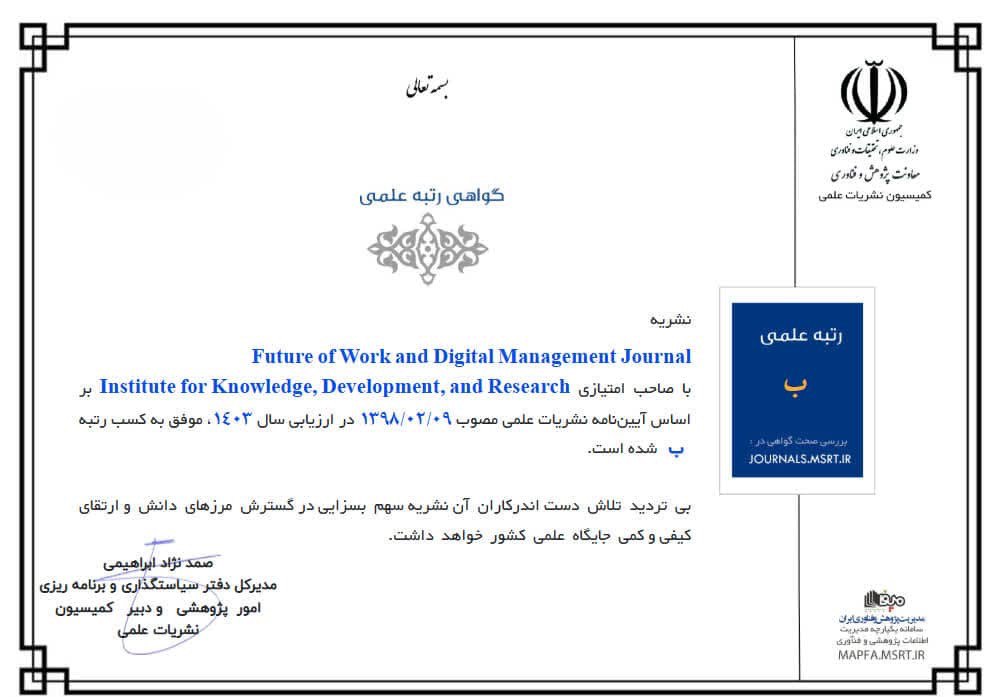Virtual Work Rituals and Their Role in Maintaining Team Culture
Keywords:
virtual teams, team culture, work rituals, remote work, team cohesion, psychological safety, digital collaborationAbstract
This study aimed to explore how virtual work rituals contribute to the maintenance and reinforcement of team culture in remote work environments. Using a qualitative research design, this study collected data through semi-structured interviews with 27 remote professionals working in virtual teams in Tehran. Participants were selected via purposive sampling, and interviews continued until theoretical saturation was achieved. Data were analyzed using thematic analysis following Braun and Clarke’s six-phase approach, supported by NVivo 12 software to assist with coding and organization. The study focused on participants’ lived experiences, symbolic practices, and emotional perceptions of virtual rituals as cultural mechanisms within their digital teams. Thematic analysis revealed three main categories: Rituals as Cultural Reinforcers, Structure and Regularity of Rituals, and Adaptability and Innovation. Each category comprised subcategories such as shared identity formation, emotional anchoring, behavioral standardization, participant-driven innovation, and technological adaptation. Participants described how virtual rituals—such as scheduled check-ins, celebratory events, symbolic expressions, and digital storytelling—enhanced team cohesion, maintained psychological safety, and reinforced cultural continuity. Rituals were also found to mitigate isolation, build trust, and promote inclusivity. These results align with prior studies that emphasize the symbolic, emotional, and structural functions of rituals in distributed teams, particularly in sustaining team identity and engagement. Virtual work rituals serve as crucial mechanisms for reinforcing team culture in remote environments by creating emotional, symbolic, and behavioral continuity. Organizations and team leaders can leverage such rituals to foster cohesion, inclusion, and psychological safety across geographically dispersed teams. As remote work becomes more prevalent, understanding and intentionally designing virtual rituals will be vital to sustaining resilient and connected team cultures.
Downloads
References
[1] H. M. Watanuki and R. d. O. Moraes, "Team Dispersion, Emergent States, and Performance in Virtual IT Service Provisioning Teams," International Journal of Information Systems in the Service Sector, vol. 14, no. 1, pp. 1-16, 2021, doi: 10.4018/ijisss.287577.
[2] M. K. Pasupuleti, "Balancing Act: The Psychological Effects of Remote Work on Employee Well-Being and Workplace Culture," pp. 49-67, 2024, doi: 10.62311/nesx/17908.
[3] J. Passmore, D. Tee, and R. Gold, "Team Coaching Using LSP and Team Facilitation: A Randomized Control Trial Study Measuring Team Cohesion and Psychological Safety," Journal of Work-Applied Management, vol. 17, no. 1, pp. 119-132, 2024, doi: 10.1108/jwam-12-2023-0137.
[4] Y. L. Cai, "Strengthening Perceptions of Virtual Team Cohesiveness and Effectiveness in New Normal: A Hyperpersonal Communication Theory Perspective," Asian Business & Management, vol. 22, no. 4, pp. 1649-1682, 2023, doi: 10.1057/s41291-023-00225-6.
[5] P. R. Palos‐Sánchez, P. Baena‐Luna, and D. Silva-O’Connor, "Exploring Employees’ Beliefs Regarding the Potential Benefits of Virtual Worlds for Group Cohesion: Gather Town," Multimedia Tools and Applications, vol. 82, no. 16, pp. 24943-24965, 2022, doi: 10.1007/s11042-022-14308-7.
[6] S. B. Sedrine, A. Bouderbala, and H. Nasraoui, "Leadership Style Effect on Virtual Team Efficiency: Trust, Operational Cohesion and Media Richness Roles," The Journal of Management Development, vol. 40, no. 5, pp. 365-388, 2020, doi: 10.1108/jmd-10-2018-0289.
[7] M. Chaudhary, S. Chopra, and J. Kaur, "Cohesion as a Cardinal Antecedent in Virtual Team Performance: A Meta-Analysis," Team Performance Management, vol. 28, no. 5/6, pp. 398-414, 2022, doi: 10.1108/tpm-02-2022-0017.
[8] N. S. Hill and I. Villamor, "The Influence of Team Cultural Value Orientations on Norms of Conduct in Hybrid Teams: Implications for Team Cohesion and Performance," Group Processes & Intergroup Relations, vol. 26, no. 7, pp. 1436-1456, 2022, doi: 10.1177/13684302221123922.
[9] M. Gentilin and M. A. G. Madrigal, "Virtual Leadership: Key Factors for Its Analysis and Management," Management Revue, vol. 32, no. 4, pp. 343-365, 2021, doi: 10.5771/0935-9915-2021-4-343.
[10] L. Hofeditz, M. Harbring, M. Mirbabaie, and S. Stieglitz, "Working With ELSA – How an Emotional Support Agent Builds Trust in Virtual Teams," 2022, doi: 10.24251/hicss.2022.050.
[11] H. Patel et al., "Building Cohesion in Distributed Telemedicine Teams Findings From the Department of Veterans Affairs National Telestroke Program," 2020, doi: 10.21203/rs.3.rs-39716/v1.
[12] H. Patel et al., "Building Cohesion in Distributed Telemedicine Teams: Findings From the Department of Veterans Affairs National Telestroke Program," 2020, doi: 10.21203/rs.3.rs-39716/v2.
[13] S. Mysirlaki and F. Paraskeva, "Virtual Team Effectiveness: Insights From the Virtual World Teams of Massively Multiplayer Online Games," Journal of Leadership Studies, vol. 13, no. 1, pp. 36-55, 2019, doi: 10.1002/jls.21608.
[14] C. K. Tan, T. Ramayah, A. P. Teoh, and J. H. Cheah, "Factors Influencing Virtual Team Performance in Malaysia," Kybernetes, vol. 48, no. 9, pp. 2065-2092, 2019, doi: 10.1108/k-01-2018-0031.
[15] N. D. Racolța-Paina, A. Luncasu, I. Metz, and S. E. ZĂGan, "Leading Virtural Teams During Covid-19," 2022, doi: 10.24818/imc/2021/04.08.
[16] R. Amewuda and T. F. Ocansey, "Comparative Analysis of Communication, Team Cohesion, Flexibility, and Productivity in Virtual and in-Person Project Management: Evidence From Germany," Journal of Project Management Practice, vol. 4, no. 2, pp. 77-96, 2024, doi: 10.22452/jpmp.vol4no2.5.
[17] Y. Jian, "Athletic Behavioral Practices in the Perspective of the Confucian Values and Team Cohesion Towards a Behavior Management Program in Jiangsu Province, China," International Journal of Social Science and Human Research, vol. 7, no. 01, 2024, doi: 10.47191/ijsshr/v7-i01-110.
[18] V. Kontsevyi, "Improving the Competency of It Project-Based-Organizations by the Usage of Virtual Teams," Management of Development of Complex Systems, no. 58, pp. 33-41, 2024, doi: 10.32347/2412-9933.2024.58.33-41.
[19] O. Torro, J. Holopainen, H. Jalo, H. Pirkkalainen, and A. Lähtevänoja, "How to Get Things Done in Social Virtual Reality – A Study of Team Cohesion in Social Virtual Reality–enabled Teams," 2022, doi: 10.24251/hicss.2022.057.
[20] S. Vashisth, "How H R Practices Can Be Optimized for Effective Management of Remote and Virtual Team in IT Industry," Interantional Journal of Scientific Research in Engineering and Management, vol. 08, no. 04, pp. 1-5, 2024, doi: 10.55041/ijsrem32612.
[21] P. Yoon, S. S. Han, and K. Kim, "Effects of Team-Building on Group Cohesion, Group Efficacy, and Individual Academic Performance in Virtual Learning Environment," Active Learning in Higher Education, vol. 26, no. 1, pp. 255-275, 2024, doi: 10.1177/14697874241229422.
[22] C. Dey and G. M.P, "Impact of Team Design and Technical Factors on Team Cohesion," Team Performance Management, vol. 26, no. 7/8, pp. 357-374, 2020, doi: 10.1108/tpm-03-2020-0022.
[23] R. Grossman and D. Mazer, "Too Good to Give Up? How Individuals’ Team and Contextual Experiences Shape Their Turnover Intentions," The Psychologist-Manager Journal, vol. 24, no. 4, pp. 220-249, 2021, doi: 10.1037/mgr0000121.
[24] N. Vukašinović, J. Benedičič, and R. Žavbi, "Evolution of Communication Skills in Virtual Product Development Process: Experience From EGPR," 2020, doi: 10.5772/intechopen.90059.
[25] H. Singh, G. Cascini, and C. McComb, "Comparing Virtual and Face-to-Face Team Collaboration: Insights From an Agent-Based Simulation," 2021, doi: 10.1115/detc2021-66043.








